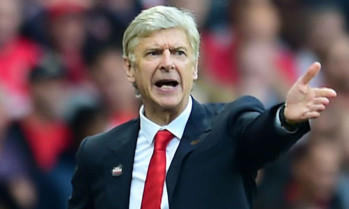
Is Arsene Wenger’s time in charge at Arsenal drawing to a close?
As a Frenchman, Arsene Wenger understood the irony when his questioner asked if Arsenal’s season was a case of deja vu.
Wenger’s dark mood in the Emirates Stadium media room following the home defeat by Manchester United was broken by a rueful smile and the acknowledgement that, yes, it does look like we’ve been here before. Many times.
We’re not quite out of November and already we know that Arsenal won’t win the Premier League.
We also know they probably won’t win the Champions League, either. They’ve progressed out of their group for 15 consecutive years yet won only eight knock-out ties.
They’re out of the Capital One Cup so that leaves the FA Cup as the single trophy they can realistically target. Just like last year.
And, as usual, Wenger is being criticised.
This week Alisher Usmanov, who owns 30% of the club’s shares, claimed that the manager’s “restrictive principles” were a problem and that Wenger makes mistakes but never accepts them.
By that he meant that Wenger has had money to spend in the transfer market but has left it in the bank.
Usmanov also reckoned the team needs to strengthen in every position to compete with other top clubs.
It was a pretty accurate reflection of the radio phone-ins and social media sites.
The gist of it is this: Wenger is too stubborn; he hasn’t kept pace with changes in the game; he was good but he’s now past his sell-by date.
He might know the meaning of deja vu, but he claimed in his response to Usmanov: “When you are such a long time in football as I am, you don’t understand any more what crisis means. I must get to the dictionary.”
And in a nutshell that’s the issue.
Wenger does not consider his team’s form to be a problem. Not this season or in any other in the decade since they last won the League. Nor, Usmanov apart, do the club’s owners.
As a business, Arsenal are very happy. More money is coming in than is going out. Generous dividends are paid to shareholders. And the man responsible for those healthy returns is cherished and rewarded.
Why would Arsenal want to risk what they have for the off-chance a bit of glory with another manager?
They have a wonderful stadium, can charge the highest prices of any organisation in the whole sporting world and have a team that’s capable of playing sublime football.
Wenger’s brief every season is the same: Qualify for the Champions League. It doesn’t matter what you do once you’re in it, just get there. And he always delivers.
But it makes being a Gooner more frustrating than being a fan of any other club.
Graeme Souness says that Arsenal will always be a nearly club. So close to being world beaters, yet never taking that final step.
Souness, Usmanov and those Gunners fans who flood the airwaves are all on about the same thing.
They believe that Wenger could have won so much more in the last decade if only he’d paid as much attention to not conceding goals as he has to scoring them.
He has a great track record in identifying and developing midfield ball players and skilful strikers, but when did he last buy a decent defender or find someone to win a tackle in midfield?
Some argue that he’s never been able to spot a top-class defender and that all his early success came because he was gifted that legendary defence.
What other manager would consider going into a season with only two central defenders, as Wenger did this time?
He could get four injuries in midfield without weakening it, but one defensive injury to Laurent Koscielny and he was stuffed.
He was told how risky that was but he ignored the warnings. Just like when he went through the entire campaign with Olivier Giroud as his only striker and got away with it.
“Arsene knows best” was a mantra during the trophy-winning days. The perception is that’s no longer the case.
So what do Arsenal do? Wenger has a contract until 2017 and would be expensive to sack. Considering what he’s done for the club over 18 years, no-one has the appetite to do it.
Unless he decides he’s had enough and walks away, Wenger will be manager next season and the one after that. And it will be deja vu all over again.

Enjoy the convenience of having The Sunday Post delivered as a digital ePaper straight to your smartphone, tablet or computer.
Subscribe for only £5.49 a month and enjoy all the benefits of the printed paper as a digital replica.
Subscribe